Related Research Articles
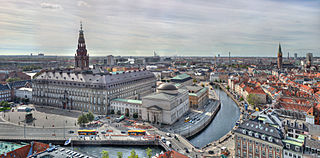
Copenhagen is the capital and most populous city of Denmark, with a population of around 660,000 in the municipality and 1.4 million in the urban area. The city is on the islands of Zealand and Amager, separated from Malmö, Sweden, by the Øresund strait. The Øresund Bridge connects the two cities by rail and road.

The history of Copenhagen dates back to the first settlement at the site in the 11th century. From the middle of the 12th century it grew in importance after coming into the possession of Bishop Absalon, and the city was fortified with a stone wall during the 13th century. The harbour and the excellent possibilities for herring fishing contributed to Copenhagen's growth and development into an important trading centre. It was repeatedly attacked by the Hanseatic League as the Germans became aware of its expansion. In 1254, it received its charter as a city under Bishop Jakob Erlandsen.

Christoffer Valkendorff was a Danish-Norwegian statesman and landowner. His early years in the service of Frederick II brought him both to Norway, Ösel and Livland. He later served both as Treasurer and Stadtholder of Copenhagen and finally as Steward of the Realm from 1596 to 1601. He owned Glorup Manor on Funen from 1535 to 1601, whose current main building he constructed, although it has later been adapted in the Neoclassical style. He constructed the old Town Hall in Bergen, and he also constructed Svindinge Church, on Funen, one of the best preserved Renaissance style churches in Denmark. He founded the dormitory Valkendorfs Kollegium in Copenhagen where the street Valkendorfsgade is named after him.

The Gustmeyer House is a historic property on Ved Stranden, opposite Christiansborg Palace on Slotsholmen, in central Copenhagen, Denmark. It was built in 1797 to a Neoclassical design by Johan Martin Quist. The Nobel Prize-winning physicist Niels Bohr was born in the building. McKinsey & Company is now based in the building.
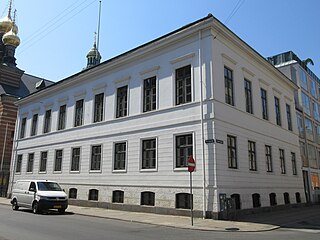
The (A. N.) Hansen Mansion is a Neoclassical town house in the Frederiksstaden neighbourhood of central Copenhagen, Denmark. Completed in 1835 to designs by Jørgen Hansen Koch, it now houses a fashion innovation centre.
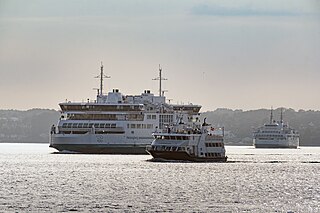
The Helsingør–Helsingborg ferry route is a shipping route connecting Helsingør (Elsinore), Denmark and Helsingborg, Sweden across the northern, and narrowest part of the Øresund. Due to the short distance, which is less than 3 nautical miles, is it one of the world's busiest international car ferry routes, with around 70 daily departures from each harbour. The oldest-known written mention of the route dates to the German traveller Adam of Bremen in the 11th century, but it has likely been in use much longer. Before 1658, the route was a domestic Danish route. For several centuries, the route has been run regularly by various Danish shipping lines. Its significance grew during the 1950s, but since the inauguration of the Øresund Bridge in 2000, at the southern end of the Øresund, it has lost some significance but remains as one of the world's most important ferry routes, particularly as a cheaper alternative to the bridge tolls. Since 1952, passports have not been required for citizens of the Nordic Passport Union countries. Since 2001, when both countries became members of the Schengen Area, passports are not needed for anyone.

Nyhavn 63 is a historic townhouse overlooking the Nyhavn Canal in central Copenhagen, Denmark. The building is listed on the Danish Registry of Protected Buildings and Places. A warehouse in the courtyard has been converted into a hostel.

Nyhavn 41 is a listed property overlooking the Nyhavn canal in central Copenhagen, Denmark. For most of the 19th century, the property was owned by a family of sailmakers. The manufacturing of flags and compasses was also part of their trade. The building was listed in the Danish registry of protected buildings and places in 1918.
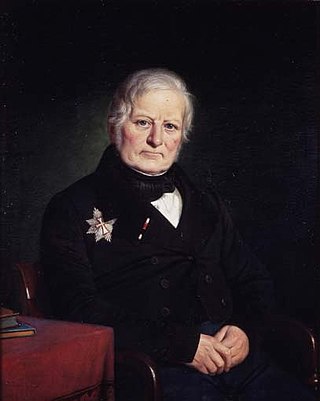
Nicolai Abraham Holten was a Danish civil servant in the financial administration and director of Øresund Custom House.
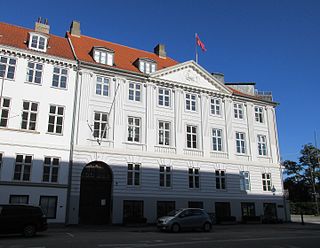
Amaliegade 40, formerly known as Toldbodbørsen, is a Neoclassical property located at the corner of Amaliegade and Esplanaden in the Frederiksstaden district of Copenhagen, Denmark. The shipping company D/S Norden was based in the building for more than one hundred years. It was listed in the Danish registry of protected buildings and places in 1918.

Kronprinsessegade 28 is a listed, Neoclassical property overlooking Rosenborg Castle Garden in central Copenhagen, Denmark. It was listed on the Danish registry of protected buildings and places in 1945. The building was for many years owned by the politician and busi businessman L. N. Hvidt. Other notable former residents include naval officer Poul de Løvenørn, politician and jurist Anders Sandøe Ørsted, archeologist Jens Jacob Asmussen Worsaae, government official and publisher Jens Peter Trap, architect Ferdinand Meldahl, hournalist and politician C. St. A. Bille (1828-1898) and Fyldendal-publisher Peter Nansen.
Thiele is a chain of retail opticians headquartered in Copenhagen, Denmark. The company is owned by Jens Henrik Brandt (95%) and Profil Optik (5%).
Johan Rudolph Thiele was a Danish book printer. He founded a successful printing business in Copenhagen in 1771 which was later continued as H. H. Thiele by his son Hans Henrik Thiele. The company survived until 1937. Another son, Frederik Anton Thiele, founded N. A. Thiele, a manufacturer and retailer of scientific instruments which would later develop into one of Denmark's leading chains of retail opticians under the name Thiele. A third son was the art historian and writer Just Mathias Thiele.

Bianco Luno was a Danish book printer. His printing business, Bianco Lunos Bogtrykkeri, was at the time of his death in 1852 the largest company of its kind in Denmark. The street Bianco Lunos Allé in Frederiksberg is named after him.

Valkendorfsgade 36, situated opposite the House of the Holy Ghost, off the shopping street Strøget is a Baroque style townhouse in the Old Town of Copenhagen, Denmark. The building was listed on the Danish registry of protected buildings and places in 1918.

Kaspar Rostrup was a Danish lawyer, joiner and local politician. From 1886, he was the owner of N. P. Rostrup, a Copenhagen-based coffin manufacturer and retailer headquartered at Valkendorfsgade 36. He was a member of the Copenhagen City Council from 1894 to 1900, as well as president of the Association of Craftsmen in Copenhagen from 1896 and of the Confederation of Danish Employers from 1907 to 1911.

Klosterstræde 21 is a four-storey building in the Old Town of Copenhagen, Denmark. It has since its completion in 1817 been home to a glazier's business. The current owner, H. P. Plsem & Søn, which has been based in the building since 1938, has replaced all the windows with antique stained glass windows. The building was listed on the Danish registry of protected buildings and places in 1950.

Snaregade 10 is a Neoclassical property located close to Gammel Strand in the Old Town of Copenhagen, Denmark. The book printing business J. D. Qvist & Co was from some time during the 19th century and until at least the 1950s based in the building. The football club KB was on 26 April 1876 founded in the apartment of one of the owners. The property was listed on the Danish registry of protected buildings and places in 1945. Its most characteristic feature is the inwardly curved facade of a former warehouse in the courtyard on its rear.

Gråbrødretorv 11 is a property situated on the south side of Gråbrødretorv in the Old Town of Copenhagen, Denmark. Originally a brewer's house from 1731, it was adapted and heightened by one storey in the first half of the 1840s. It was around the same time expanded with a four-storey residential building at Valkendorfsgade 20 on the other side of the block. The entire complex was listed in the Danish registry of protected buildings and places in 1932.

Kringlegangen is a passageway linking the square Gråbrødretorv with the street Valkendorfsgade in the Old Town of Copenhagen, Denmark. A bakery was operated on the site from before 1787 until at least the 1910s. The present building complex was constructed in 1856-1857 for master joiner Carl Heinrich Winther. The passageway was not opened to the public until 1975. The name Kringlegangen was inspired by a gilded kringle above the entrance from Gråbrødretorv as well as to the twisting and turning course of the passageway. The entire building complex was listed in the Danish registry of protected buildings and places in 1945.
References
- ↑ "H.H. Thiele". coneliand.dk (in Danish). Retrieved 21 August 2018.
- ↑ "Valkendorfsgade 7-9". indenforvoldene.dk (in Danish). Retrieved 21 August 2018.